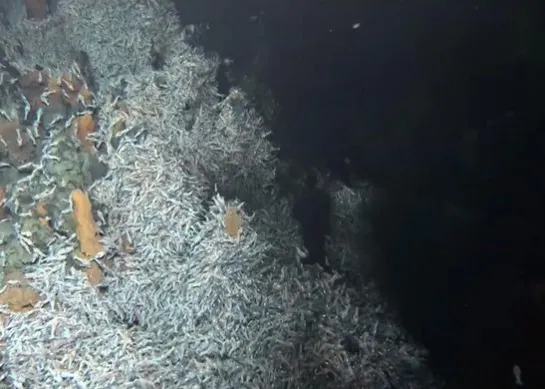The deep seabed, a hostile and uncharted environment
Total darkness, pressure and cold: extreme conditions to explore the secrets of the abysses.
- 4mn read

Imagine diving beneath the surface of the ocean and gradually descending into the depths. At a depth of 200 metres, light is scarce, and at 1,000 metres, darkness reigns. As you descend, the pressure increases and the temperature drops.
Welcome to the abyss, a hostile and still predominantly unexplored environment, but one where underwater life has managed to flourish.
Darkness
Below 200 m, there’s no more light!
The depths of the ocean have been the source of endless fantasies and stories, and the absence of light adds a mysterious and spooky dimension to this environment.
Below 200 metres, sunlight no longer penetrates to the depths and we reach what is known as the aphotic zone. The lack of light means that plant life disappears because photosynthesis relies on the sun’s energy. Phytoplankton, at the base of food chains, can no longer develop.

For a long time, it was thought that the absence of light prevented life from thriving at great depths, but it has now been discovered that animal life actually manages to thrive.
The deep-sea food chain depends on the surface. Plankton animals and organisms that die close to the surface fall down to the seabed - this shower of particles is called “marine snow”. Species that live on the seabed, such as sea cucumbers, feed on this nutritional detritus and in turn, serve as prey for other animals.
Deep-sea animals thrive in the dark, with protruding eyes like those of the giant squid, as well as bioluminescence, which enables them to see one another, communicate with a partner to breed or to attract prey.
Pressure
Pressure is a physical phenomenon!
At the surface of the sea, the pressure averages just over 1 bar; once underwater, it increases by 1 bar for every 10 m of depth. This means that water pressure reaches 1,000 bar in the vast ocean trenches at a depth of 10,000 metres.
This immense pressure is equivalent to 1 metric ton pressing down on your little finger or the weight of a small car on a postage stamp.
Here too, the animals have successfully adapted to this environment and to the ambient pressure. For example, the pink snailfish has been seen at a depth of 8,336 metres in the Pacific, in the Izu-Ogasawara Trough, which joins the Mariana Trench. This fish, which breaks all depth records, has a soft skeleton, a gelatinous body with no scales and no swim bladder, and it could not survive at the surface of the ocean.

Cold
No more than 3°C!
The cold conditions that prevail at the bottom of the sea make it an unwelcoming environment. Temperatures average no more than 3°C all year round, and even fall to as low as 0.5°C below 5,000 metres.
This hostile world does not prevent life from developing.
It is a simple fact that scientists are constantly learning as they explore the deep seabed: in areas where there is little food and no photosynthesis, life in the abyss is extremely abundant and remains largely undiscovered. In some recently explored areas, scientists estimate that 90% of the species living there are new to science!
The deep seabed still has many secrets to reveal and it is vital that these vulnerable ecosystems are protected and preserved.

Crédits photos : © Ifremer/MNHN - C/O Kanadeep 2019 - CCBY
Ifremer (2018). Biodiversité du site hydrothermal TAG. Ifremer. https://image.ifremer.fr/data/00701/81346/
© Ifremer - Bicose (2014)
We must join forces to protect the deep seabed!
Nausicaá endorses France’s position against deep-sea mining and will use every means at its disposal to raise awareness and mobilise as many people as possible in support of a moratorium.












